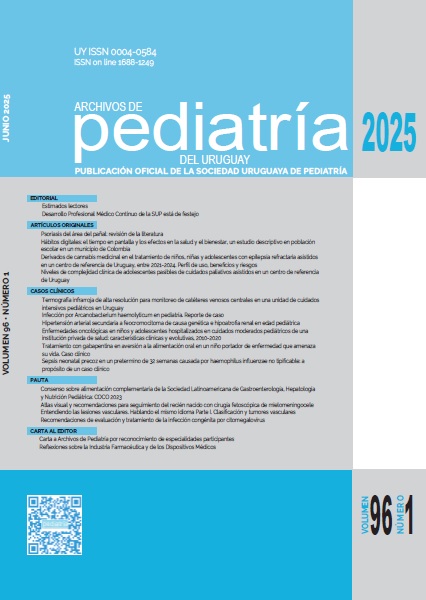Abstract
Introduction: vascular access is an indispensable tool for children care in the Pediatric Intensive Care Unit (PICU). Infection due to the use of central venous catheters (CVC) is the main cause of intrahospital infection in PICUs. Thermography has great potential, due to the fact that it is a non-invasive method, it does not cause adverse effects, it does not require sedation, it does not require moving a critical patient and it does not generate ionizing radiation. It has high sensitivity and specificity to provide information on the metabolism, perfusion and inflammation o f a region of interest.
Methodology: the FLIR E75 high-resolution sensor (FLIR Systems AB, Taby, Sweden) was used, with a thermal sensitivity of 0.03°C, an IR resolution of 307.200 pixels. The measurement of the average and maximum T°C deltas was carried out (ΔTaverage ΔTmax). In this work, 2 clinical cases of patients were described in which infrared imaging was used in the follow-up of 2 confirmed infections linked to the use of CVC, where asymmetries and altered thermal dysfunctions with ΔTaverage greater than 1°C were observed in the described cases. In turn, both cases present ΔTmax greater at 2.0°C.
Conclusions: the use of the infrared image could be promising as a semiological tool for the follow-up of CVC during their stay at the PICU.
References
Muñoz J, Roselló P. Canalización de vías venosas centrales. An Pediatr Contin 2005; 3(2):109-13.
New K, Webster J, Marsh N, Hewer B. Intravascular device use, management, documentation and complications: a point prevalence survey. Aust Health Rev 2014; 38(3):345-9. doi: 10.1071/AH13111.
Sociedad Española de Medicina Intensiva Crítica y Unidades Coronarias. Guía de práctica clínica sobre el uso de catéteres venosos centrales de inserción periférica (PICC) en el paciente crítico. Madrid: SEMICYUC, 2021.
Cantirán K, Telechea H, Menchaca A. Incidencia de bacteriemia asociada al uso de accesos venosos centrales en cuidados intensivos de niños. Arch Pediatr Urug 2019; 90(2):57-62. doi: 10.31134/ap.90.2.2.
Sanchez J. Protocolo de infección relacionada con el catéter venoso central. Madrid: SECIP, 2020. Disponible en: https://www.secip.info/images/uploads/2020/07/Infección-asociada-a-CVC.pdf. (Consulta: 10 marzo 2024).
Ammer K. The Glamorgan protocol for recording and evaluation of thermal images of the human body. Thermol Int 2008; 18(4):125-9.
Gatt A, Formosa C, Cassar K, Camilleri K, De Raffaele C, Mizzi A, et al. Thermographic patterns of the upper and lower limbs: baseline data. Int J Vasc Med 2015; 2015:831369. doi: 10.1155/2015/831369.
Devito K, Americano J. Can infrared thermography replace other methods for evaluating the presence and intensity of neurogenic and musculoskeletal orofacial pain in adult patients? A systematic review. Inplasy Protocol 2023: 202330091. doi: 10.37766/inplasy2023.3.0091.
Howell K, Smith R. Guidelines for specifying and testing a thermal camera for medical applications. Thermol Int 2009; 19:5-12.
Machado S, Tortorella M, Medeiros C, Negrin A. Uso da imagem infravermelha em caso de envenenamento de uma criança picada por Bothrops Pubescens (Cope, 1870) no Uruguay. Pan Am J Med Thermol 2023; 10:e2023005. doi: 10.18073/pajmt.2023.10.005.
Fernández I, Marins J, Lastras J, Carmona P, Cano S, García MÁ, et al. Classification of factors influencing the use of infrared thermography in humans: a review. Infrared Phys Technol 2015; 71:28-55. doi: 10.1016/j.infrared.2015.02.007.
Lahiri A. Medical applications of infrared thermography: a review. Infrared Phys Technol. 2012;55(4):221-35.
Ramirez J, Bartlett R, Arriaga J, Fraser R, Saiko G. Infrared thermography in wound care, surgery, and sports medicine: a review. Front Physiol 2022; 13:838528. doi: 10.3389/fphys.2022.838528.
Silvah J, Lima C, Unamuno M, Schetino M, Schetino L, Fassini P, et al. Body surface infrared thermometry in patients with central venous cateter-related infections. Einstein (Sao Paulo) 2015; 13(3):364-9. doi: 10.1590/S1679-45082015AO3397.
Benavent O, Benavente N, Priego J, Galindo C, Cibrián R, Salvador R, et al. Application of infrared thermography in diagnosing peripherally inserted central venous catheter infections in children with cancer. Physiol Meas 2019; 40(4):044002. doi: 10.1088/1361-6579/ab031a.
Kacmaz S, Ercelebi E, Zengin S, Cindoruk S. The use of infrared thermal imaging in the diagnosis of deep vein thrombosis. Infrared Phys Technol 2017; 86:120-9. doi: 10.1016/j.infrared.2017.09.005.
International Academy of Clinical Thermology. International Academy of Clinical Thermology Medical Infrared Imaging Standards and Guidelines. Redwood City, CA: IACT, 2018. doi: 10.13140/RG.2.2.28341.78562.

This work is licensed under a Creative Commons Attribution 4.0 International License.
Copyright (c) 2025 Archives of Pediatrics of Uruguay


